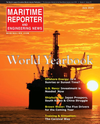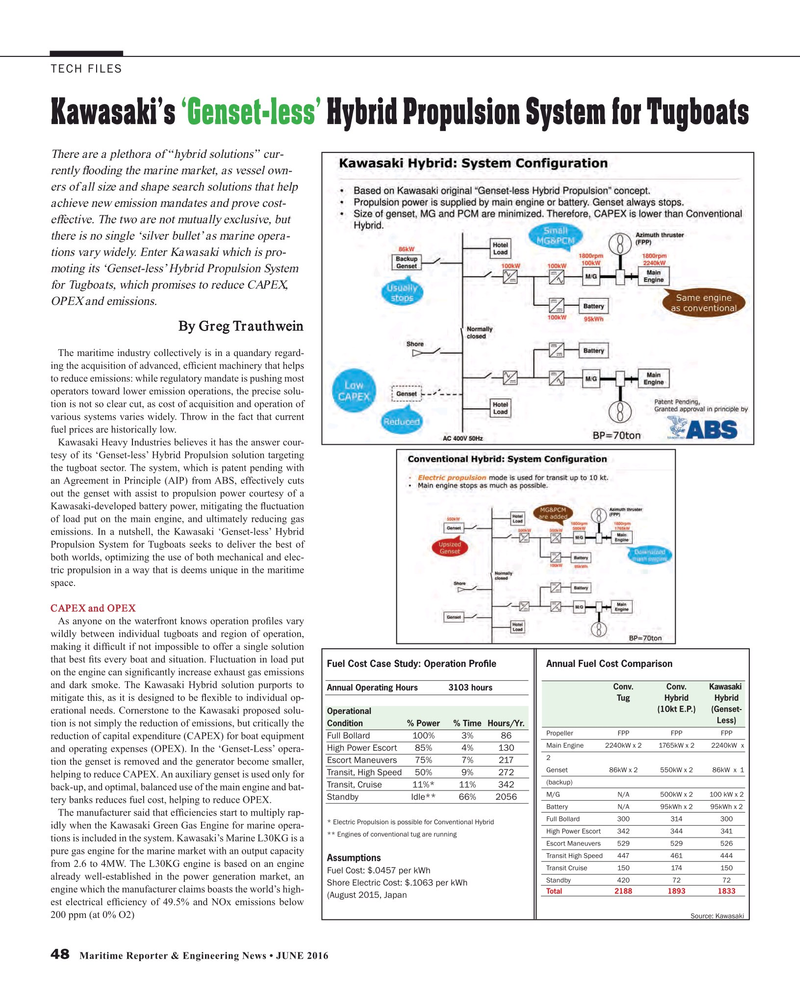
Page 48: of Maritime Reporter Magazine (June 2016)
Annual World Yearbook
Read this page in Pdf, Flash or Html5 edition of June 2016 Maritime Reporter Magazine
TECH FILES
Kawasaki’s ‘Genset-less’ Hybrid Propulsion System for Tugboats
There are a plethora of “hybrid solutions” cur- rently ? ooding the marine market, as vessel own- ers of all size and shape search solutions that help achieve new emission mandates and prove cost- effective. The two are not mutually exclusive, but there is no single ‘silver bullet’ as marine opera- tions vary widely. Enter Kawasaki which is pro- moting its ‘Genset-less’ Hybrid Propulsion System for Tugboats, which promises to reduce CAPEX,
OPEX and emissions.
By Greg Trauthwein
The maritime industry collectively is in a quandary regard- ing the acquisition of advanced, ef? cient machinery that helps to reduce emissions: while regulatory mandate is pushing most operators toward lower emission operations, the precise solu- tion is not so clear cut, as cost of acquisition and operation of various systems varies widely. Throw in the fact that current fuel prices are historically low.
Kawasaki Heavy Industries believes it has the answer cour- tesy of its ‘Genset-less’ Hybrid Propulsion solution targeting the tugboat sector. The system, which is patent pending with an Agreement in Principle (AIP) from ABS, effectively cuts out the genset with assist to propulsion power courtesy of a
Kawasaki-developed battery power, mitigating the ? uctuation of load put on the main engine, and ultimately reducing gas emissions. In a nutshell, the Kawasaki ‘Genset-less’ Hybrid
Propulsion System for Tugboats seeks to deliver the best of both worlds, optimizing the use of both mechanical and elec- tric propulsion in a way that is deems unique in the maritime space.
CAPEX and OPEX
As anyone on the waterfront knows operation pro? les vary wildly between individual tugboats and region of operation, making it dif? cult if not impossible to offer a single solution that best ? ts every boat and situation. Fluctuation in load put
Fuel Cost Case Study: Operation Pro? le Annual Fuel Cost Comparison on the engine can signi? cantly increase exhaust gas emissions and dark smoke. The Kawasaki Hybrid solution purports to Conv. Conv. Kawasaki
Annual Operating Hours 3103 hours Tug Hybrid Hybrid mitigate this, as it is designed to be ? exible to individual op- (10kt E.P.) (Genset- erational needs. Cornerstone to the Kawasaki proposed solu-
Operational Less)
Condition % Power % Time Hours/Yr. tion is not simply the reduction of emissions, but critically the
Propeller FPP FPP FPP
Full Bollard 100% 3% 86 reduction of capital expenditure (CAPEX) for boat equipment
Main Engine 2240kW x 2 1765kW x 2 2240kW x
High Power Escort 85% 4% 130 and operating expenses (OPEX). In the ‘Genset-Less’ opera- 2
Escort Maneuvers 75% 7% 217 tion the genset is removed and the generator become smaller,
Genset 86kW x 2 550kW x 2 86kW x 1
Transit, High Speed 50% 9% 272 helping to reduce CAPEX. An auxiliary genset is used only for (backup)
Transit, Cruise 11%* 11% 342 back-up, and optimal, balanced use of the main engine and bat-
M/G N/A 500kW x 2 100 kW x 2
Standby Idle** 66% 2056 tery banks reduces fuel cost, helping to reduce OPEX.
Battery N/A 95kWh x 2 95kWh x 2
The manufacturer said that ef? ciencies start to multiply rap-
Full Bollard 300 314 300 * Electric Propulsion is possible for Conventional Hybrid idly when the Kawasaki Green Gas Engine for marine opera-
High Power Escort 342 344 341 ** Engines of conventional tug are running tions is included in the system. Kawasaki’s Marine L30KG is a
Escort Maneuvers 529 529 526 pure gas engine for the marine market with an output capacity
Transit High Speed 447 461 444
Assumptions from 2.6 to 4MW. The L30KG engine is based on an engine
Transit Cruise 150 174 150
Fuel Cost: $.0457 per kWh already well-established in the power generation market, an
Standby 420 72 72
Shore Electric Cost: $.1063 per kWh engine which the manufacturer claims boasts the world’s high-
Total 2188 1893 1833 (August 2015, Japan est electrical ef? ciency of 49.5% and NOx emissions below 200 ppm (at 0% O2)
Source: Kawasaki 48 Maritime Reporter & Engineering News • JUNE 2016
MR #6 (42-49).indd 48 6/6/2016 2:03:59 PM

 47
47

 49
49
